Mitrephora wangii is a species of plant in the family Annonaceae. It is native to China and Thailand.

Goniothalamus ridleyi is a species of plant in the family Annonaceae. It is native to Borneo, Peninsular Malaysia, Sumatra and Thailand. George King, who first formally described the species, named it after the English botanist Henry Nicholas Ridley who collected the specimen King examined.
Goniothalamus rongklanus is a species of plant in the family Annonaceae. It is native to Thailand. Richard Saunders and Piya Chalermglin first formally described the species and named it after Phu Hin Rong Kla National Park in Thailand.
Goniothalamus tortilipetalus is a species of plant in the family Annonaceae. It is native to Peninsular Malaysia and Thailand. Murray Ross Henderson, the Scottish botanist who first formally described the species, named it after its twisted petals.
Mitrephora glabra is a species of plant in the family Annonaceae. It is native to Borneo. Rudolph Scheffer, the Dutch botanist who first formally described the species, named it after its hairless leaves and mature twigs.

Mitrephora heyneana is a species of plant in the family Annonaceae. It is native to India and Sri Lanka. Joseph Dalton Hooker and Thomas Thomson, the British botanists who first formally described the species under the basionym Orophea heyneana, named it after Benjamin Heyne a German botanist who collected and described many plant species from India.

Mitrephora keithii is a species of plant in the family Annonaceae. It is native to Myanmar, Peninsular Malaysia and Thailand. Henry Nicholas Ridley, the English botanist who first formally described the species, named it in honor of Dr. A. Keith who collected the sample that Ridley examined.
Mitrephora macclurei is a species of plant in the family Annonaceae. It is native to China, Laos and Vietnam. Aruna Weerasooriya and Richard Saunders, the botanists who first formally described the species, named it after Floyd Alonzo McClure of Lingnan University, who collected the holotype specimen that they examined.
Mitrephora calcarea is a species of plant in the family Annonaceae. It is native to Laos and Vietnam. Aruna Weerasooriya and Richard M.K. Saunders, the botanists who provided the first valid formal description of the species, named it after the limy soil it grows in. The name follows a prior invalid account by Suzanne Jovet-Ast, which lacked a Latin description.
Mitrephora macrocarpa is a species of plant in the family Annonaceae. It is native to Sulawesi. Friedrich Anton Wilhelm Miquel, the Dutch botanist who first formally described the species using the basionym Orophea macrocarpa, named it after its large fruit.
Mitrephora pallens is a species of plant in the family Annonaceae. It is native to Vietnam. Suzanne Jovet-Ast, the French botanist who first formally described the species, named it after its pale flowers.
Mitrephora petelotii is a species of plant in the family Annonaceae. It is native to Vietnam. Aruna Weerasooriya and Richard Saunders, the botanists who first formally described the species, named it in honor of the French botanist Paul Alfred Pételot, who collected the holotype specimen that they examined.
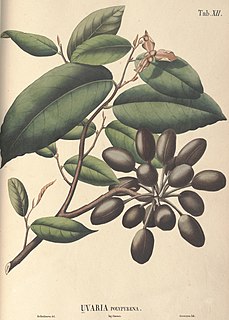
Mitrephora polypyrena is a species of plant in the family Annonaceae. It is native to Java, the Lesser Sunda Islands, and Myanmar. Carl Ludwig Blume, the German botanist who first formally described the species using the basionym Uvaria polypyrena, named it after the many stones or seeds in its fruit.

Mitrephora maingayi is a species of plant in the family Annonaceae. It is native to Bangladesh, Borneo, Cambodia, Laos, Peninsular Malaysia, Myanmar, Sumatra, and Vietnam. Joseph Hooker and Thomas Thomson, the British botanists who first formally described the species, named it in honor of Alexander Carroll Maingay, the British botanist who collected the specimen they examined.
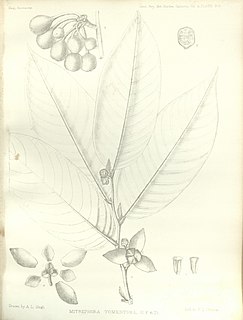
Mitrephora tomentosa is a species of plant in the family Annonaceae. It is native to Bangladesh, Cambodia, Laos, Myanmar, Thailand, and Vietnam. Joseph Hooker and Thomas Thomson, the British botanists who first formally described the species, named it after the dense covering of hair on its young branches, leaves and flowers.
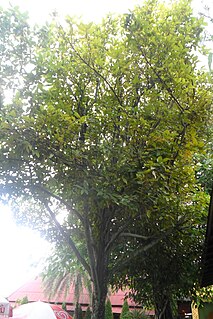
Mitrephora winitii is a species of plant in the family Annonaceae. It is native to Myanmar and Thailand. William Grant Craib, the British botanist who first formally described the species, named it after Phya Winit Wanandor, the Thai botanist who collected the specimen that Craib examined. In the Prachuap Khiri Khan province of Thailand it is commonly referred to as Mahaphrom.
Pseuduvaria costata is a species of plant in the family Annonaceae. It is native to New Guinea. Rudolph Scheffer, the Dutch botanist who first formally described the species using the basionym Orophea costata, named it after its prominently ribbed fruit.
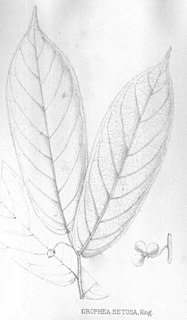
Pseuduvaria setosa is a species of plant in the family Annonaceae. It is native to Peninsular Malaysia. George King, the botanist who first formally described the species under the basionym Orophea setosa, named it after the bristly hairs on its leaves and petioles.
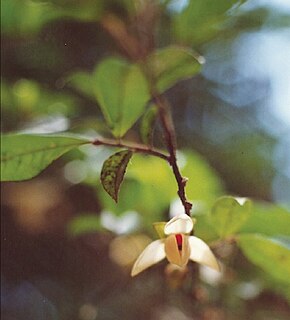
Uvariastrum insculptum is a species of plant in the Annonaceae family. It is native to Cameroon, Gabon, Ghana, Ivory Coast, Liberia, Nigeria, and the Republic of the Congo. Adolf Engler and Ludwig Diels, the botanists who first formally described the species using the basionym Uvaria insculpta, named it after the secondary veins on its leaves which are distinctly sunken.
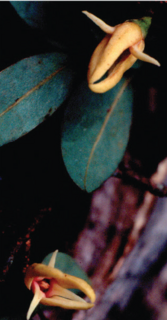
Xylopia arenaria is a species of plant in the Annonaceae family. It is native to Kenya, and Tanzania. Adolf Engler, the botanist who first formally described the species, named it after its growth in sandy places.









